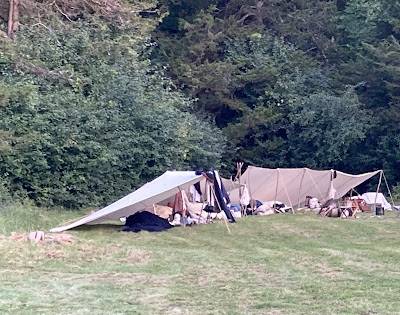October 21, 1777, was the second full day of marching for the German column of the Convention Army. Once again, Massachusetts Militiaman Joshua Pillsbury noted just the basics in his account:
"Tusday Greenbush 15 [miles]". Brunswicker Grenadier Johann Bense noted a bit, but not much more:
"14 Miles out of New City in the woods". [1]
Greenbush, New York, just across the Hudson River from Albany, was first occupied by Europeans 150 years earlier. Dutch settlers began farming in the area in 1628 according to Greenbush Historical Society. The Greenbush of 1777 covered a large area, which was broken up in 1855 into North Greenbush, East Greenbush and the City of Rensselaer. Today, the state of New York operates the Crailo State Historic Site to tell the story the occupation of the region by Dutch farmers. Crailo is named after the Van Rensselaer estate in the Netherlands, variously spelled Crayloo or Cralo in the 17th century, and meaning "crows' wood" in Dutch. The house was built in the early 18th century, but remodeled several times before being donated to the state in 1924.
October 21st was a difficult day for many of the Germans. Summer in New York and New England was over. It had snowed and rained the night before. Their fourteen mile march to Greenbush was made on roads that were hilly and poor. At night
"it froze hard". [2] Despite their expectation of at least minimal quarters along the way,
Major-General Friedrich Adolph Riedesel's Germans found themselves sleeping outside, on the ground. (Riedesel himself did not, at least at this point, as he was in Albany with his wife and children, in the
home of American Major-General Philip Schuyler.)
Two sources offer us more details on the march of the German column than either Pillsbury or Bense. One is the
Specht Journal, translated from German into English by historian and professor
Dr. Helga Doblin and published by the Greenwood Press in 1995. The journal is thought to be translation of a journal kept by the Brunswicker von Specht Regiment's adjutant, Lieutenant Anton Adolph Heinrich Du Roi. It covers the period from the regiment's departure from Germany in 1776 through November 9, 1777, two days after its arrival at Winter Hill, and includes a highly detailed day by day account account of the march from Saratoga to Cambridge. The late Professor Doblin was responsible for translating a number of accounts kept by German soldiers who fought in America during the Revolutionary War, including that of
Company Surgeon Julius Friedrich Wasmus, who was captured at Bennington.
The second is
Letters From America 1776-1779, translated generations earlier by Dr. Ray W. Pettengill and published by Houghton-Mifflin in 1924. Pettengill's introduction indicates his translation of this source is not the first. Pettengill notes the letters in his work were used in 1884 by Edwin Lowell in
The Hessians and Other German Auxiliaries of Great Britain in the Revolutionary War, and translated by William Leete Stone for inclusion in 1891 in
Letters of Brunswick and Hessian Officers During the American Revolution, but both works were incomplete and contained errors. The letters had been published in Germany in the eighteenth century in a multi-volume series of documents regarding the German military,
Briefwechsel, by August Ludwig Schlozer.
At first glance the Specht Journal and the "Letters From Cambridge In New England" in Letters From America appear to be entirely separate sources for accounts of the march. There is however considerable overlap between the two. It may be that the keeper of the journal was also the author of the letters on the Saratoga campaign that appear in the book. A couple of examples suggest this.
One involves the account the towns they passed through. Both tell of the settlement of "New City" (Lansingburg, New York) as a planned community, with smiths and bakers whose houses stood empty. [3] There are similarities in their description of the march to Greenbush as well. In addition to mentioning roads that were poor and hilly, and snow and rain on the night of the 21st, both mention that the houses were a quarter-mile apart, they camped in the woods near the house of a rich farmer named Woolesworth, and that night it froze hard. [4]
Another is a description of women, after arriving in Kinderhook, New York, the following day. In both, there are common observations: very white skin, healthy complexion without makeup ("having to paint" in one, "natural freshness" in the other), pretty eyes, hair done up daily, and always wearing gloves and a wrap when they go out. [5] Like many things, the German and the British accounts of the women they met along the way is the topic for another post.
A while back I shared that the present-day town of West Brookfield (then still a part of Brookfield), further east on the Convention Army's route of march, holds an
Asparagus Festival on their town common. The festival commemorates what they claim was the introduction of asparagus into the United States some time between 1794 and 1798. The Crailo State Historic Site's Facebook page challenges that claim. According to a quote posted for "National Asparagus Day", asparagus
was being grown in 1665 in the herb gardens of Dutch colonists in what was then "New Netherland". Either way, that reminder of Dutch settlement in North America can be found along the route of the Convention Army.
[1] Pillsbury, p. 787; Bense, p. 75.
[2] Letters From America, p. 115.
[3] Letters From America, p. 115; Specht Journal, p. 103.
[4] Letters From America, p. 115; Specht Journal, p. 103.
[5] Letters From America, pp. 116-117; Specht Journal, p. 104.
For more on the Convention Army's 1777 march from Saratoga to Boston, see:




Comments
Post a Comment